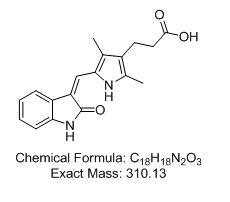|
5-[(1,2-Dihydro-2-oxo-3H-indol-3-ylidene)methyl]-2,4-dimethyl-1H-pyrrole-3-propanoic acid (NSC 702827; SU 6668; TSU 68)
• ATP-competitive PDGFR, VEGF and FGFR inhibitor (IC50 values are 0.06, 2.43, 3.04 and > 100 μM at PDGFRβ, VEGFR2, FGFR1 and EGFR respectively). Inhibits proliferation of HUVEC and NIH3T3 cells in vitro (IC50 values are 0.41, 9.3 and 16.5 μM for VEGF, FGF and PDGF-stimulated growth respectively) and induces > 75% growth inhibition against a broad range of tumor types in vivo.

OTAVAchemicals Catalogue Number: 1156360
CAS Registry Number: 252916-29-3
Purity: 95%+ (HPLC)
Ref. 1: Fabbro & Manley. SU-6668, SUGEN. Current Opinion in Investigational Drugs (2001), 2, 1142-1148
Abstract: SUGEN is developing SU-6668, a tyrosine kinase inhibitor that inhibits three distinct growth factor receptor targets, for the potential treatment of cancer.
Ref. 2: Sun et al. Design, Synthesis, and Evaluations of Substituted 3-[(3- or 4-Carboxyethylpyrrol-2-yl)methylidenyl]indolin-2-ones as Inhibitors of VEGF, FGF, and PDGF Receptor Tyrosine Kinases. Journal of Medicinal Chemistry (1999), 42, 5120-5130
Abstract: Receptor tyrosine kinases (RTKs) have been implicated as therapeutic targets for the treatment of human diseases including cancers, inflammatory diseases, cardiovascular diseases including arterial restenosis, and fibrotic diseases of the lung, liver, and kidney. Three classes of 3-substituted indolin-2-ones containing propionic acid functionality attached to the pyrrole ring at the C-3 position of the core have been identified as catalytic inhibitors of the vascular endothelial growth factor (VEGF), fibroblast growth factor (FGF), and platelet-derived growth factor (PDGF) RTKs. Some of the compounds were found to inhibit the tyrosine kinase activity associated with isolated vascular endothelial growth factor receptor 2 (VEGF-R2) [fetal liver tyrosine kinase 1 (Flk-1)/kinase insert domain-containing receptor (KDR)], fibroblast growth factor receptor (FGF-R), and platelet-derived growth factor receptor (PDGF-R) tyrosine kinase with IC50 values at nanomolar level.
|
 HOME
HOME ABOUT
ABOUT
 SERVICES
SERVICES
 PRODUCTS
PRODUCTS
 Targeted Libraries
Targeted Libraries
 Biochemicals
Biochemicals
 RESEARCH
RESEARCH
 DOWNLOADS
DOWNLOADS ORDERING
ORDERING
 CONTACTS
CONTACTS


